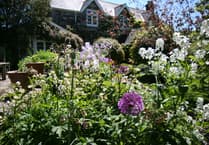A THREE day public inquiry begins today (Tuesday) by the Planning Inspectorate against Dartmoor National Park Authority’s decision to refuse to grant planning permission and to serve enforcement notices on Steward Wood Community Woodland in Moretonhampstead, for a development that the authority felt had a harmful impact on the special character of the national park and its purposes.
Steward Wood is designated as ‘woodland having conservation importance’ under Section 3 of the Wildlife and Countryside Act 1981. A small part of the site is designated Ancient and Semi Natural Woodland by the Forestry Commission and Natural England.
Following the purchase of the site, a number of dwellings were constructed. A retrospective planning application was subsequently submitted in November 2000 for a ‘low impact, sustainable development with agricultural/forestry enterprise, incorporating educational and residential elements’. That application was refused and the appeal dismissed, however, an appeal against the subsequent enforcement notice was successful and a temporary permission was granted by the Planning Inspectorate in 2002.
There have been subsequent applications and appeals with temporary planning permission again being granted by the Inspector in 2009, subject to a range of conditions. The most recent temporary permission ran out in June 2014.
The latest planning permission was refused in April 2015 and four enforcement notices were served in June 2015. It is against these decisions the current appeal is made.
The national park authority has said it will always take action against unauthorised residential developments within the national park, to protect and conserve the special qualities of the national park, as it is charged to do under the Environment Act 1995.
The case that Dartmoor National Park Authority will set out to the inspector is summarised as follows:
• Some of the low impact dwellings that were granted temporary permission have been replaced by larger more substantial residential structures, made from timber and plywood with UPVC windows. This constitutes an unauthorised housing development within the national park.
• The development does not provide or make provision for affordable accommodation for local people in housing need and sets no limit for how many people can live within the site.
• The need to permanently live on the land to manage the woodland and host educational courses has not been proven.
• There is concern about the failure to manage the woodland properly, with particular concern over the restoration and management of the ancient woodland that forms part of Steward Wood.
• The community does not live in a genuinely sustainable, self-sufficient way. Several residents commute to work each day, little food is grown on the land and there are several motor vehicles kept and used by the residents.
• The experimental approach to permaculture lacks clear evaluation as to how successful it has been and is unable to demonstrate that the site has been fully self-sufficient with regard to growing food.
James McInnes, chair of the national park’s Development Management Committee, said: ‘This is to all intents and purposes a new settlement within the national park. As such it must follow the same planning law as any other residential development in England, whether it’s "low impact" or constructed by a major housing developer.
‘There is no evidence to show the need for constructing residential dwellings on the site to support the management of the woodland. Our role is to manage the national park and ensure that development within it is genuinely essential.’



-with-lightning).jpeg?width=209&height=140&crop=209:145,smart&quality=75)
Comments
This article has no comments yet. Be the first to leave a comment.